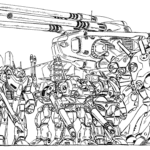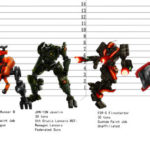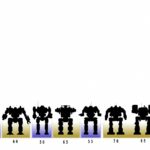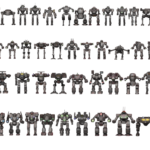Modern forces deploy across Space, and that means so do their APCs and other armored vehicles. To make this easier, tanks for example now stand tall and come standard with robotic legs doubling as landing shocks. Colloquially, these walking war machines are called BattleMechs. They make up the bulk of the Space-faring mechanized infantry.
–
Table of Contents:
- Introduction
- Chassis Types
- Classifications
- Variants
- Further Details
–
Introduction:
A BattleMech (often abbreviated ‘Mech, although that could technically also refer to Industrial Mechs) is an armored combat vehicle of roughly humanoid shape, standing 8 to 14 meters tall and typically massing from 20 to 100 tons. ‘Mechs are best suited for ground combat, although they are also capable of operations underwater, in hazardous environments and in space.
In general, BattleMechs are considered superior to conventional combat vehicles, being faster, better armed, and better protected, creating a firepower-to-manpower ratio which also gives them a logistical advantage. ‘Mechs replicate many of the movements humans are capable of performing, including acrobatic feats such as shoulder rolls, which allow them to avoid, deflect or otherwise lessen the impact of weapons fire. Their downside is the incredible expense associated with producing and maintaining ‘Mechs – even the cheapest ‘Mech can cost millions of C-Bills – ensuring cheaper combat vehicles a continued role in warfare. Still, the best way to fight a ‘Mech is with another ‘Mech, preferably one larger and more powerful: duels between evenly-matched ‘Mechs have been known to last for hours.
–
Chassis Types
Bipedal: Covering the vast majority of the types of BattleMechs, bipedal ‘Mechs come in three types:
Humanoid-type BattleMechs with knee-joint legs are the most commonly encountered BattleMechs; iconic ‘Mechs of this kind include the Wasp, Phoenix Hawk, Warhammer, Atlas and Summoner (Thor).
Reverse joint (chicken-walker) bipedal ‘Mechs are slightly less common on the field of battle, but include such famous ‘Mechs as the Locust, Catapult, Marauder, and Timber Wolf (Mad Cat).
Digitigrade bipedal mechs that have hip, knee, ankle, and toe joints and walk on their toes are the rarest of the three. Examples include the Thanatos, Nova Cat, and Mongoose.
Tripodal: ‘Mechs normally have two or four legs. The only three-legged ‘Mechs known are the exotic Colossal class Ares and Superheavy Poseidon ‘Mechs which appeared in the early 3130s, and the heavy-class Triskelion BattleMech which appeared in the 3140s. The Hedgehog was previously mentioned as a tripodal ‘Mech from the Star League era, having allegedly been introduced in 2602, but it is not considered canonical.
Quadrupedal: The Quad ‘Mech uses its “arms” for legs which gives these designs some additional stability and maneuverability (such as sidestepping, also known as lateral shift movement). The concept was much maligned for sacrificing the overall versatility of BattleMechs and the early designs, notably the Scorpion and the Goliath, proved flawed, being notoriously difficult to maintain and highly susceptible to breakdowns. It was only around the year 3060 that improved technology led to new quadrupedal ‘Mech designs, although the stigma associated with the general concept still lingers. Bipedal BattleMechs remain the vastly more common ‘Mech.
Land-Air ‘Mech (LAM): A special, and very rare, type of BattleMechs based on common designs, the Land-Air ‘Mechs (aka LAM) can transform from a regular BattleMech form into an Aerospace Fighter, or an intermediate form referred to as LAM Mode. While performing just like a conventional BattleMech or Aerospace Fighter in the respective form (to the point of being kept in either ‘Mech bays or fighter hangars aboard DropShips), in LAM Mode these ‘Mechs can quickly traverse great distances, giving them a tactical advantage in ground combat although their real niche apparently is reconnaissance. However, their delicate technology is unduly susceptible to damage and the combat performance of Land-Air ‘Mechs fell short of expectations by a long margin, especially considering their exorbitant production and maintenance costs. Land-Air ‘Mechs were only produced in small numbers and the ability to maintain and repair (or even produce) them was largely lost early on in the succession wars. The concept quickly faded into obscurity from a combination of small numbers, maintenance shortfalls and combat attrition.
The Clans abhor the concept, as it dilutes their strict distinction between ‘Mechs and aerospace forces. Clan Nova Cat famously took great care to raze the last remaining LAM factory to the ground during the Clan Invasion. Only Clan Jade Falcon is known to have delved into LAM research, but the project was terminated in 3059 after only two prototypes (Evil Twin One and Evil Twin Two) had been built; the scientists found the Land-Air Mechs to be too unstable to field in normal combat.
QuadVee: A variation of the LAM type BattleMech. The QuadVee is a hybrid of the Quadrupedal style BattleMech and the Combat Vehicle which has conversion equipment to switch between two modes. The QuadVee was developed by the Clan Hell’s Horses during the later part of the Dark Age Era. It’s creation was a means for the Clan to bolster it’s Touman. The QuadVee requires a two man crew (gunner and pilot) to operate. The crew sit in the armless torso/turret of the machine. The machine’s vehicle form can be equipped with either Track or Wheels for their mode of transportation. Unlike most Quad Mechs, the QuadVee has a unique Turret like torso that may spin 360 degree. This is typically where most of the QuadVee’s weaponry is housed. These ‘Mechs are currently available in normal BattleMech weight classes. QuadVees uniquely continue to move should they loose their Gyro by converting the machine into Vehicle mode. They are able to be setup to be either standard QuadVee or modular as an OmniQuadVees. In the few years the Hell’s Horses have utilized it, the vehicle has received mixed reviews.[22]
–
Classifications
Ultralight:
Although it is technically possible to build “ultralight” ‘Mechs of 15 or even 10 tons, most ‘Mechs in this range are IndustrialMech designs. Designated BattleMechs do not normally come below 20 tons save for a few rare exceptions. Some agencies, namely including the Draconis Combine Mustered Soldiery, define a BattleMech as massing at least 20 tons and therefore do not consider ultralight ‘Mechs proper BattleMechs.[23]
The arguably most famous ultralight design (and also the first that was ever published) is the FLE-14 subvariant of the Flea, massing 15 tons while most other variants weigh in at 20 tons.
Ultralight ‘Mechs should not be confused with ProtoMechs which, while approximately of the same weight, are of a fundamentally different design compared to ‘Mechs.
Light:
All ‘Mechs weighing from 20 up to 35 tons are classified as “light”. Their skeleton can only carry limited armor, but the higher efficiency of smaller fusion reactors means that light ‘Mechs benefit from superior mobility. They are typically fast but lightly armed and armored. These ‘Mechs are generally used as scout ‘Mechs and anti-personnel units instead of frontline combat duty, but some are designated combat ‘Mechs with relatively heavy armament. Their low production cost, high proliferation, and relatively good supply of spare parts meant that they saw widespread use throughout history in virtually any role.
Famous light scout ‘Mechs include the Locust, Stinger, and Wasp, while the Commando, Jenner, and Panther are powerful combat units for their size. Clan technology provides their designs such as the Adder (Puma) with firepower equaling Inner Sphere ‘Mechs twice their size.
Notable specialized light designs include the Ostscout Recon ‘Mech with its advanced sensor gear, the Raven ECM ‘Mech, and the Firestarter Incendiary ‘Mech.
Medium:
Medium ‘Mechs are the workhorse ‘Mechs of most armies. Weighing between 40 and 55 tons they naturally fall somewhere in between the agile light ‘Mechs and the powerfully armed heavy ‘Mechs. While matching neither in their respective niche, medium ‘Mechs tend to have the best combination between speed, armor, and payload which gives them unmatched versatility. The fastest medium ‘Mechs often serve as command units among light ‘Mechs with similar speed. Better armed than light ‘Mechs, medium ‘Mechs can often outmaneuver heavier opponents in combat and bring their weapons to bear with better effect to the point of being superior combatants in single combat, given time and suitable terrain.
Common medium ‘Mech designs include the Phoenix Hawk, Vindicator, Centurion, Shadow Hawk, Griffin, and Wolverine, and the Clan designs Nova (Black Hawk) and Stormcrow (Ryoken).
Heavy:
Heavy ‘Mechs are those designed for frontline combat duty, and weigh in between 60 and 75 tons. They are slightly less versatile and generally slower than medium ‘Mechs, but tend to have much heavier armor and weapon payloads. Capable of delivering sustained heavy fire over long ranges while retaining adequate mobility, they are formidable and powerful foes. Some designs are adapted to special roles in combat which greatly improves the combat performance of their unit but makes them a poor choice in single combat situations.
Typical examples of heavy ‘Mech designs are the Crusader, Thunderbolt, Warhammer, Marauder and the Clan Mad Dog (Vulture), Summoner (Thor) and Timber Wolf (Mad Cat) designs.
The Rifleman is notorious for its anti-air capabilities, and the Archer for its long-range missile barrages.
Assault:
Assault ‘Mechs are the heaviest regular class of BattleMechs, weighing in between 80 and 100 tons. Some of these huge ‘Mechs can mount up to 50 tons of weapons as well as very thick armor protection. They can project tremendous firepower, and perform best as the spearhead of frontal assaults or in defending entrenched positions. The trade-off is in speed and maneuverability, as assault ‘Mechs are generally very slow. As such, they often require friendly units to protect them from being outmaneuvered. Assault ‘Mechs are typically used as command units, heavy assault platforms, and in fire-support roles, but due to their prohibitive costs and limited production, they actually make up only a small fraction of all BattleMechs.
Iconic Assault ‘Mechs include the Mackie, Atlas, and Stalker and the Clan Warhawk (Masakari) and Dire Wolf (Daishi) designs.
The BattleMaster and Cyclops are well-known command ‘Mechs, as both have above average electronics packages geared towards command & communication while maintaining heavy weapon payloads.
Superheavy:
Since the late 28th century, designers had attempted to construct BattleMechs in excess of 100 tons. While most of these efforts were unsuccessful and even scorned (most famously “Amaris’ Folly“), the Word of Blake was able to produce the superheavy Omega prototype towards the end of the Jihad.
In the early 3120s, tripodal superheavy ‘Mechs called “colossal” BattleMechs began appearing as an experimental technology. Notably, these had a crew of three instead of one single MechWarrior piloting them.
The colossal ‘Mechs Poseidon and Ares (an OmniMech) are manned by a crew of three (Pilot, Gunner, and Engineer) and tipped the scales at between 125 and 135 tons. The known standard omni configurations of the Ares are called “Hades“, “Hera“, “Zeus“, “Aphrodite“, and “Hephaestus“.
–
Variants
OmniMechs:
OmniMechs, a concept introduced by the Clans and later adopted by the Successor States of the Inner Sphere, feature hardpoints with interchangeable weaponry whereas classic BattleMechs have a fixed configuration. Designed as combat vehicles, BattleMechs are modular to an extent and thus relatively easy to repair and maintain. Even throughout the Lostech era of the Succession Wars, scavenged battlefield salvage could keep them operational despite their technology not being understood anymore. However, changing out the weapons and equipment of a ‘Mech can require extensive refitting which might result in the chance of malfunctioning.
Industrial ‘Mechs:
IndustrialMechs (also known as WorkMechs, UtilityMechs or, where applicable, ICE ‘Mechs), though far less glamorous than their war-faring counterparts, are very important in the everyday life of the BattleTech universe. There are AgroMechs, ForestryMechs and LoggerMechs, LoaderMechs, MiningMechs, and many other types for many different industries including even armed SecurityMechs. Many of these ‘Mechs use an internal combustion engine (ICE), usually diesel, due to the high cost of fusion reactors.
Industrial ‘Mechs have occasionally been modified for war when normal ‘Mechs are out of reach (most often in the MechWarrior: Dark Age saga), although the modified WorkMech is usually far less capable than a BattleMech of the same tonnage. They tend to be equipped with relatively light armor, but can pack a deadly punch in close combat with varying array of industrial-grade tools including saws, drills and utility lasers.
–
Further Details:
For a list of most of the ‘mechs’ you’ll see ‘out there’, navigate here.
–
–








